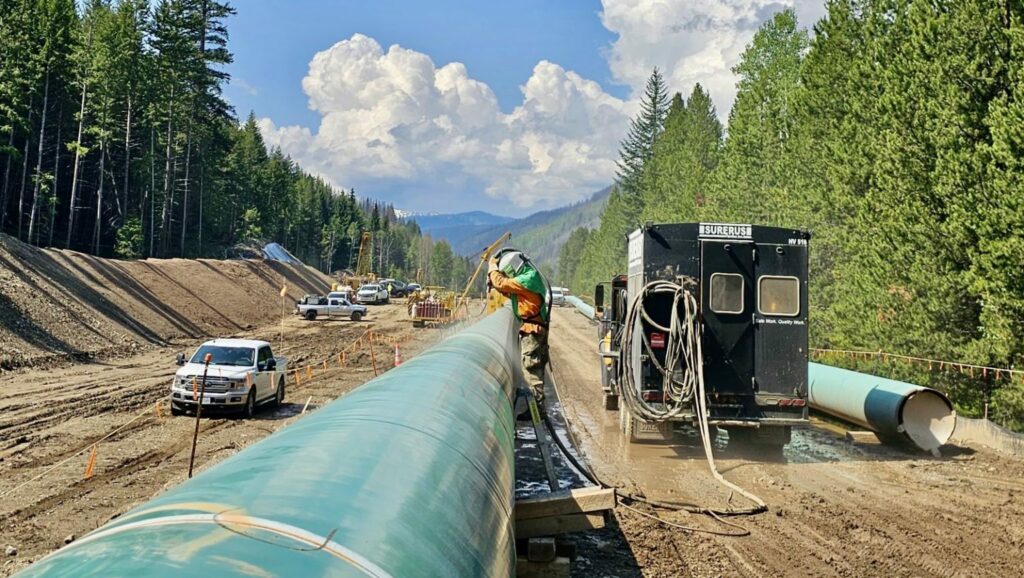Indigenous people represent about 11 per cent of the project’s total workforce as of the end of 2022
By James Snell
Follow CEC on Linkedin CEC Linkedin
Follow CEC on Facebook CEC Facebook
Follow CEC on Twitter CEC Twitter

Treylynd Jules (left), a 23-year-old member of the Skeetchestn Indian Band, works on the Trans Mountain pipeline expansion. Photo provided to Canadian Energy Centre
Treylynd Jules is thriving as he helps build the Trans Mountain pipeline expansion.
The 23-year-old member of the Skeetchestn Indian Band works as a coater/sandblaster on the project, which stretches from Edmonton to the Vancouver area. Jules sandblasts and paints welded pipe joints with industrial-grade paint – critical work to protect the pipeline from corrosion over its decades of operation.
He is one of more than 3,100 Indigenous people who have been hired to work on the $30.9 billion project.
“There’s lots of money to be made and it can really help a lot of people out,” says Jules.
The main community of the Skeetchestn band, located about 60 kilometres west of Kamloops, B.C., had about 240 residents as of 2021, according to Statistics Canada. The unemployment rate sat at 17 per cent, more than double the provincial average of 8.4 per cent.
There are many Indigenous people working on the project, says Jules – adding morale is high on his crew.

Treylynd Jules, a 23-year-old member of the Skeetchestn Indian Band, works on the Trans Mountain pipeline expansion. Photo provided to Canadian Energy Centre
Jules says his greatest challenge is learning to manage money. He’s also on the sobriety journey and determined to represent his community. He’s thankful for the mental health counsellors that are provided by the company free of charge to workers. He is considering home ownership and one day having a family.
The Trans Mountain project says it is working closely with Indigenous communities.
“We have achieved an unprecedented level of Indigenous involvement in the expansion project—through job creation, procurement opportunities, partnerships, and the environmental process,” CEO Dawn Farrell said in the company’s June report on environmental, social and governance performance.
The company says Indigenous people represent about 11 per cent of the project’s total workforce as of the end of 2022.
Around 25 per cent of project contracts have been awarded to Indigenous businesses and partnerships – totaling around $4.8 billion.
“Many Indigenous workers have become involved in the oil and gas, mining, and forestry sectors to benefit from good, high-paying careers – and socioeconomic impact comes from the economic impact,” says John Desjarlais, board chair of the Indigenous Resource Network (IRN).
Indigenous people make nearly three times more in the energy sector than in other industries – $140,400 versus $51,120, according to recent census data published in a report by the IRN.
“These numbers show the resource sector is valuing the skills and experience that Indigenous workers bring to the table,” Desjarlais says.
The original Trans Mountain Pipeline, now being twinned with 980 kilometres of new pipe and 12 new pump stations, started operating in 1953. It is Canada’s only corridor for transporting crude and refined products to international markets via vessels loaded in Burnaby.
Construction of the expansion is over 80 per cent complete. When it starts operating in 2024, pipeline capacity will climb from 300,000 to around 890,000 barrels per day.
The unaltered reproduction of this content is free of charge with attribution to Canadian Energy Centre Ltd.
Share This:



